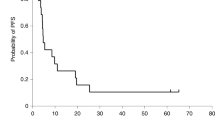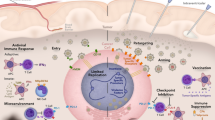Abstract
The application of adeno-associated virus (AAV) vectors to cancers is limited by their low transduction efficiency. Previously, we reported that γ-ray enhanced the second-strand synthesis, leading to the improvement of the transgene expression, and cytocidal effect of the herpes simplex virus type-1 thymidine kinase (HSVtk) and ganciclovir (GCV) system. In this study, we extended this in vitro findings to in vivo. First, the laryngeal cancer cell line (HEp-2) and HeLa were treated with AAVtk/GCV, the number of surviving cells was reduced as the concentration of GCV increased. Furthermore, the 4 Gy irradiation enhanced the killing effects of AAVtk/GCV by four-fold on HeLa cells and 15-fold on HEp-2 cells. Following the in vitro experiments, we evaluated the transgene expression and the antitumor activity of the AAV vectors in combination with γ-ray in nude mice inoculated with HEp-2 subcutaneously. The LacZ expression was observed in the xenografted tumors and significantly increased by γ-ray. The AAVtk/GCV system suppressed the tumors growth, and γ-ray augmented the antitumor activity by five-fold. These findings suggest that the combination of AAVtk/GCV system with radiotherapy is significantly effective in the treatment of cancers and may lead to reduction of the potential toxicity of both AAVtk/GCV and γ-ray.
This is a preview of subscription content, access via your institution
Access options
Subscribe to this journal
Receive 12 print issues and online access
$259.00 per year
only $21.58 per issue
Buy this article
- Purchase on Springer Link
- Instant access to full article PDF
Prices may be subject to local taxes which are calculated during checkout








Similar content being viewed by others
References
Merino OR, Lindberg RD, Fletcher GH . An analysis of distant metastases from squamous cell carcinoma of the upper respiratory and digestive tracts. Cancer 1977; 40: 145–151.
Clayman GL et al. In vivo molecular therapy with p53 adenovirus for microscopic residual head and neck squamous carcinoma. Cancer Res 1995; 55: 1–6.
Kunke D et al. Preclinical study on gene therapy of cervical carcinoma using adeno-associated virus vectors. Cancer Gene Ther 2000; 7: 766–777.
Su H, Lu R, Ding R, Kan YW . Adeno-associated viral-mediated gene transfer to hepatoma: thymidine kinase/interleukin 2 is more effective in tumor killing in non-ganciclovir (GCV)-treated than in GCV-treated animals. Mol Ther 2000; 1: 509–515.
Berns KI, Rose JA . Evidence for a single-stranded adenovirus-associated virus genome: isolation and separation of complementary single strands. J Virol 1970; 5: 693–699.
Blacklow NR et al. A seroepidemiologic study of adenovirus-associated virus infection in infants and children. Am J Epidemiol 1971; 94: 359–366.
Muzyczka N . Use of adeno-associated virus as a general transduction vector for mammalian cells. Curr Top Microbiol Immunol 1992; 158: 97–129.
Wagner JA et al. Efficient and persistent gene transfer of AAV-CFTR in maxillary sinus. Lancet 1998; 351: 1702–1703.
Muramatsu S et al. Behavioral recovery in a primate model of Parkinson's disease by triple transduction of striatal cells with adeno-associated viral vectors expressing dopamine-synthesizing enzymes. Hum Gene Ther 2002; 13: 345–354.
Kay MA et al. Evidence for gene transfer and expression of factor IX in haemophilia B patients treated with an AAV vector. Nat Genet 2000; 24: 257–261.
Kanazawa T et al. Gamma-rays enhance rAAV-mediated transgene expression and cytocidal effect of AAV-HSVtk/ganciclovir on cancer cells. Cancer Gene Ther 2001; 8: 99–106.
Ferrari FK, Samulski T, Shenk T, Samulski RJ . Second-strand synthesis is a rate-limiting step for efficient transduction by recombinant adeno-associated virus vectors. J Virol 1996; 70: 3227–3234.
Fisher KJ et al. Transduction with recombinant adeno-associated virus for gene therapy is limited by leading-strand synthesis. J Virol 1996; 70: 520–532.
Alexander IE, Russell DW, Miller AD . DNA-damaging agents greatly increase the transduction of nondividing cells by adeno-associated virus vectors. J Virol 1994; 68: 8282–8287.
Alexander IE, Russell DW, Spence AM, Miller AD . Effects of gamma irradiation on the transduction of dividing and nondividing cells in brain and muscle of rats by adeno-associated virus vectors. Hum Gene Ther 1996; 7: 841–850.
Peng D et al. Transduction of hepatocellular carcinoma (HCC) using recombinant adeno-associated virus (rAAV): in vitro and in vivo effects of genotoxic agents. J Hepatol 2000; 32: 975–985.
Trask TW et al. Phase I study of adenoviral delivery of the HSV-tk gene and ganciclovir administration in patients with current malignant brain tumors. Mol Ther 2000; 1: 195–203.
Hasenburg A et al. Thymidine kinase gene therapy with concomitant topotecan chemotherapy for recurrent ovarian cancer. Cancer Gene Ther 2000; 7: 839–844.
Sutton MA et al. In vivo adenovirus-mediated suicide gene therapy of orthotopic bladder cancer. Mol Ther 2000; 2: 211–217.
Makinen K et al. Evaluation of herpes simplex thymidine kinase mediated gene therapy in experimental pancreatic cancer. J Gene Med 2000; 2: 361–367.
Kawashita Y et al. Regression of hepatocellular carcinoma in vitro and in vivo by radiosensitizing suicide gene therapy under the inducible and spatial control of radiation. Hum Gene Ther 1999; 10: 1509–1519.
Rogulski KR et al. Double suicide gene therapy augments the antitumor activity of a replication-competent lytic adenovirus through enhanced cytotoxicity and radiosensitization. Hum Gene Ther 2000; 11: 67–76.
Qing K et al. Adeno-associated virus type 2-mediated gene transfer: correlation of tyrosine phosphorylation of the cellular single-stranded D sequence-binding protein with transgene expression in human cells in vitro and murine tissues in vivo. J Virol 1998; 72: 1593–1599.
Sanlioglu S, Duan D, Engelhardt JF . Two independent molecular pathways for recombinant adeno-associated virus genome conversion occur after UV-C and E4orf6 augmentation of transduction. Hum Gene Ther 1999; 10: 591–602.
Russell DW, Alexander IE, Miller AD . DNA synthesis and topoisomerase inhibitors increase transduction by adeno-associated virus vectors. Proc Natl Acad Sci USA 1995; 92: 5719–5723.
Okada H et al. Gene therapy against an experimental glioma using adeno-associated virus vectors. Gene Ther 1996; 3: 957–964.
Su H, Lu R, Chang JC, Tissue-specific expression of herpes simplex virus thymidine kinase gene delivered by adeno-associated virus inhibits the growth of human hepatocellular carcinoma in athymic mice. Proc Natl Acad Sci USA 1997; 94: 13 891–13 896.
Qiao J, Black ME, Caruso M . Enhanced ganciclovir killing and bystander effect of human tumor cells transduced with a retroviral vector carrying a herpes simplex virus thymidine kinase gene mutant. Hum Gene Ther 2000; 11: 1569–1576.
Howard BD et al. Transduction of human pancreatic tumor cells with vesicular stomatitis virus G-pseudotyped retroviral vectors containing a herpes simplex virus thymidine kinase mutant gene enhances bystander effects and sensitivity to ganciclovir. Cancer Gene Ther 2000; 7: 927–938.
Valerie K et al. Improved radiosensitization of rat glioma cells with adenovirus-expressed mutant herpes simplex virus-thymidine kinase in combination with acyclovir. Cancer Gene Ther 2000; 7: 879–884.
Buhles WC et al. Ganciclovir treatment of life- or sight-threatening cytomegalovirus infection: experience in 314 immunocompromised patients. Rev Infect Dis 1988; 10: S495–S506.
Snydman DR . Ganciclovir therapy for cytomegalovirus disease associated with renal transplants. Rev Infect Dis 1988; 10: S554–S562.
Hanna NN et al. Virally directed cytosine deaminase/5-fluorocytosine gene therapy enhances radiation response in human cancer xenografts. Cancer Res 1997; 57: 4205–4209.
Wilkie NM et al. Hybrid plasmids containing an active thymidine kinase gene of Herpes simplex virus 1. Nucleic Acids Res 1979; 7: 859–877.
Ogasawara Y et al. Efficient production of adeno-associated virus vectors using split-type helper plasmids. Jpn J Cancer Res 1999; 90: 476–483.
Matsushita T et al. Adeno-associated virus vectors can be efficiently produced without helper virus. Gene Ther 1998; 5: 938–945.
Cepko C . Preparation of a specific retrovirus producer cell line. In: Ausubel FM, Brent R, Kingston RE, Moore DD, Seidman JG, Smith JA, Struhl K (eds). Current Protocols in Molecular Biology. John Wiley & Sons: New York, 1995, pp 9.10.1–9.10.13.
Ozawa K, Kurtzman G, Young N . Replication of the B19 parvovirus in human bone marrow cell cultures. Science 1986; 233: 883–886.
Kung AL et al. Suppression of tumor growth through disruption of hypoxia-inducible transcription. Nat Med 2000; 6: 1335–1340.
Acknowledgements
We thank Dr M Nakazawa (Department of Radiology, Jichi Medical School) for technical advice and helpful discussion. We also thank Avigen Inc., for providing the plasmids, pAAVLacZ, pW1909 and plAd, and the Cell Resource Center for Biomedical Research, Tohoku University for providing the HEp-2 cells.
This work was supported in part by grants from the Ministry of Health, Labor and Welfare of Japan, Grants-in-Aid for Science Research from the Ministry of Education, Culture, Sports, Science and Technology of Japan, CREST (Core Research for Evolutional Science and Technology), and Special Coordination Funds for promoting Science and Technology of the Science and Technology Agency of Japanese Government.
Author information
Authors and Affiliations
Rights and permissions
About this article
Cite this article
Kanazawa, T., Mizukami, H., Okada, T. et al. Suicide gene therapy using AAV-HSVtk/ganciclovir in combination with irradiation results in regression of human head and neck cancer xenografts in nude mice. Gene Ther 10, 51–58 (2003). https://doi.org/10.1038/sj.gt.3301837
Received:
Accepted:
Published:
Issue Date:
DOI: https://doi.org/10.1038/sj.gt.3301837
Keywords
This article is cited by
-
Vector engineering, strategies and targets in cancer gene therapy
Cancer Gene Therapy (2022)
-
Membrane-bound MMP-14 protease-activatable adeno-associated viral vectors for gene delivery to pancreatic tumors
Gene Therapy (2022)
-
Nucleic acid targeting: towards personalized therapy for head and neck cancer
Oncogene (2016)
-
Synergistic antitumor effect of AAV-mediated TRAIL expression combined with cisplatin on head and neck squamous cell carcinoma
BMC Cancer (2011)
-
Transferrin lipoplex-mediated suicide gene therapy of oral squamous cell carcinoma in an immunocompetent murine model and mechanisms involved in the antitumoral response
Cancer Gene Therapy (2009)



